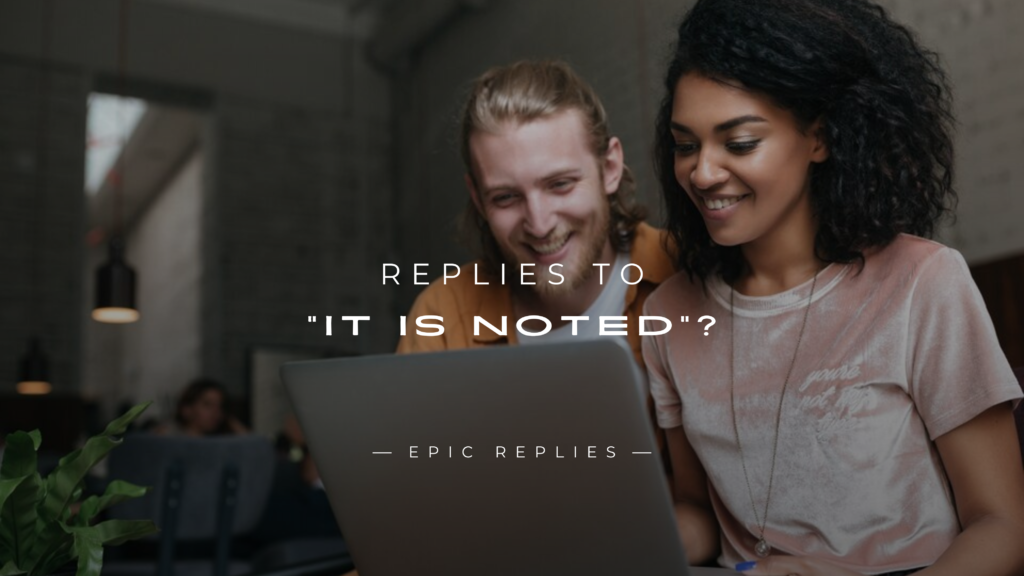In professional and personal communication, many of us encounter the phrase “It Is Noted”. On the surface, it seems straightforward, but it often leaves people questioning whether a response is necessary, and if so, what that response should look like. Whether you’re communicating in a corporate setting, sending an email, or simply having a conversation, knowing how to reply to “It Is Noted” can improve your communication skills significantly. Let’s explore the nuances and effective ways to respond to this commonly used phrase.

220+ Replies to “It Is Noted”?
Formal Acknowledgment
- Thank you for the confirmation, I will make sure to proceed accordingly.
- Acknowledged, I’ll make a note of this for future reference.
- I’ve taken note of your feedback and will act upon it.
- Understood, and I will ensure this is addressed as per your instructions.
- Your message is duly noted, and I’ll follow the necessary steps.
- Appreciate the update; this has been recorded on my end.
- Understood and documented for the next meeting.
- Thank you for highlighting that, I’ll ensure it is reflected in the project.
- This information is now on my radar, and I’ll keep it in mind moving forward.
- Noted, and I will keep this in mind for the upcoming review.
Appreciative Responses
- Thanks for bringing that to my attention, it’s helpful.
- I really appreciate the update, I’ll make sure to incorporate it.
- Thank you, that’s really useful information!
- Thanks for the heads-up, I’ll make sure to keep track of it.
- I appreciate you pointing that out; I’ll take note for next time.
- Thank you for sharing that, it helps me stay on top of things.
- Thanks for flagging this, I’ll keep it in mind.
- Much appreciated! I’ll make sure this doesn’t slip through.
- Thanks a lot for the note—this will be super helpful.
- I really value that input, thank you for letting me know.
Neutral or Minimal Acknowledgment
- Got it, thanks.
- Noted.
- Understood, noted on my end.
- Alright, noted.
- Thanks, I’ve noted that.
- Okay, got it.
- Understood.
- Noted, I’ll keep that in mind.
- Sure, I’ll take note.
- Alright, thanks for that.
Supportive/Encouraging
- Got it, thanks for the update—sounds like we’re on the right track!
- Noted, and I’m excited to see how this turns out!
- Thanks for letting me know, looks like we’re moving in the right direction.
- Got it, and I’m fully on board with this plan.
- Thanks for the note, I’m with you on this.
- Noted, and I’m happy to help in any way!
- This is great, I’ll keep track of it—let’s make it happen!
- Noted, and I’m excited to move forward together!
- Thanks for the info—I’m all in on this.
- Understood, and I’m fully aligned with what you’ve shared.
Clarification or Request for More Details
- Noted, but could you clarify what the next steps are?
- I understand, but can you expand on how this will impact our timeline?
- Thanks, but I’d appreciate a bit more detail to ensure we’re aligned.
- Got it, but could you elaborate on what exactly needs to be prioritized?
- Noted, can you please provide more context on that?
- Thanks, but just to clarify, are there any dependencies we need to consider?
- Understood, but could you explain further what actions are needed next?
- Noted, though I’d love to know more about how this fits into the broader plan.
- I’ve got it, but could you share more details on the timeline?
- Thanks, but I’d like a bit more insight before moving forward—can you elaborate?
Agreeing or Confirming
- Yes, that makes sense—duly noted.
- Agreed, I’ll take note of that.
- Absolutely, I’ll follow through based on that.
- Yes, understood and noted—I’m aligned.
- That sounds good to me, I’ll make sure to keep it in mind.
- Got it, and I’m fully in agreement.
- I completely agree, thanks for pointing that out.
- Yes, I see your point and have noted it.
- We’re on the same page—duly noted.
- Agreed, I’ll follow this as a priority.
Professional Commitment
- I’ll ensure this gets addressed right away, noted.
- Noted, I’ll take care of it and keep you updated.
- I’ll handle this as soon as possible—thanks for the note.
- Understood, and I’ll make sure it’s actioned as required.
- I’ve made a note and will follow up on this shortly.
- I’ll ensure this is included in the final report, noted.
- I’ll make sure this is resolved, noted on my end.
- I’ve got this on my list, and I’ll make it a priority.
- Noted, and I’ll make sure it’s executed as discussed.
- I’ve noted this and will ensure it’s properly handled.
Polite Deferral or Follow-up
- Noted, I’ll revisit this later today and get back to you.
- Thanks, I’ll follow up on this once I have more information.
- Understood, I’ll look into this and come back with an update soon.
- Noted, I’ll take a closer look when I have more time.
- Thanks, I’ll review it and touch base with you next week.
- Got it, I’ll keep this in mind for our next meeting.
- Understood, I’ll come back to you on this after some further thought.
- Thanks for the update, I’ll address it after I’ve handled the current tasks.
- Noted, I’ll follow up once I’ve gathered more details.
- I appreciate it, I’ll be sure to look into it and get back to you soon.
Acknowledgment with Agreement to Proceed
- Got it, I’ll move forward as planned.
- Noted, I’ll proceed with the next steps.
- Understood, and I’ll go ahead with this approach.
- Thanks for that, I’ll continue as discussed.
- All clear, I’ll take it from here and keep things moving.
- Got it, I’ll proceed with the work as outlined.
- Noted, I’ll carry on with the plan.
- Understood, and I’ll take the necessary actions.
- Thanks for the note, I’ll go ahead and move forward.
- Duly noted, I’ll take the next steps from here.
Soft Rejection or Disagreement
- Noted, but I think we might want to reconsider the timeline.
- Thanks, though I believe there may be a better approach.
- I understand, but I’d like to discuss an alternative option.
- Got it, but I’m not sure this aligns with our current priorities.
- Noted, but I think we should explore other avenues first.
- I appreciate it, but we might want to revisit this later.
- Understood, but I have some concerns we may need to address.
- Noted, though I think we might want to rethink that strategy.
- Got it, but I’m not fully convinced it’s the best direction.
- Thanks for the input, though I believe we may need to adjust course.
Casual/Informal Acknowledgment
- Cool, got it.
- Alright, noted!
- Thanks, I’ll keep that in mind.
- Gotcha, I’ve noted that.
- Okay, sounds good.
- Sure thing, noted.
- No problem, I’ll take note.
- Alright, I’ve got it, thanks!
- Got it, I’ll keep track of it.
- Okay, I’ll make sure it’s on my radar.
Optimistic/Positive Response
- Got it, looking forward to making this happen!
- Noted, and I’m excited to see how this unfolds!
- Thanks for the update—this is going to be great!
- Understood, and I’m feeling good about where we’re headed.
- Got it, I’m excited to move forward with this!
- Noted, and I can’t wait to see the results!
- Thanks, I’m feeling really positive about the next steps.
- Great, I’ll make sure to keep it moving in the right direction!
- Understood, I’m confident this will go smoothly.
- Thanks, I’m excited to continue with this plan!
Delegation or Forwarding
- Got it, I’ll pass this on to the relevant team member.
- Noted, I’ll make sure the right person gets this information.
- Thanks, I’ll delegate this to the appropriate team.
- Understood, I’ll forward this to the right people.
- Got it, I’ll make sure this is passed on to the team handling it.
- Noted, I’ll share this with the person in charge.
- Thanks for that, I’ll ensure it gets to the right department.
- Got it, I’ll forward this to the team for action.
- Noted, I’ll make sure this is handled by the right folks.
- Understood, I’ll delegate this to the appropriate contact.
Proactive Response
- Thanks, I’ll get started on this right away.
- Noted, I’ll make sure to handle this immediately.
- Got it, I’ll take action on this today.
- Understood, I’ll begin working on this right now.
- Thanks for the update, I’ll jump on this first thing.
- Noted, I’ll address this right away.
- Got it, I’ll make sure this is taken care of promptly.
- Understood, I’ll get moving on this right now.
- Thanks, I’ll begin taking the necessary steps right away.
- Noted, and I’ll handle it as soon as possible.
Reflective or Thoughtful Response
- Noted, I’ll take some time to think about this.
- Understood, I’ll reflect on this and get back to you.
- Thanks, I’ll give this further thought before proceeding.
- Noted, I’ll consider this carefully moving forward.
- I’ll take this into account and reflect on how to move forward.
- Got it, I’ll think about this before making any decisions.
- Thanks, I’ll take a step back and review this more thoroughly.
- Noted, I’ll take some time to assess the situation before proceeding.
- Understood, I’ll carefully consider the implications before moving ahead.
- I appreciate the insight, I’ll take time to reflect on it.
Request for Assistance
- Got it, but I might need your help to move this forward.
- Noted, but could you assist me with the specifics on this?
- Thanks, I’ll handle this, but I might reach out for some support.
- Understood, but I might need a bit of guidance to complete this.
- Thanks, could you give me a hand with the next steps?
- Noted, but I may need some help clarifying the details.
- I’ve got it, but I might need to ask for some assistance later on.
- Understood, but could you help me with a few of the finer points?
- Thanks, I’ll move ahead, but I might need your input if I hit a roadblock.
- Noted, though I may need your expertise on this at some point.
Deferring Action
- Got it, I’ll come back to this once I’ve finished my current tasks.
- Noted, I’ll address this after I’ve cleared my schedule a bit.
- Thanks, I’ll look into it tomorrow when I have more time.
- Understood, I’ll take care of this later this week.
- Noted, I’ll put this on my to-do list for next week.
- Got it, I’ll follow up on this once I’ve completed my priority items.
- Thanks, I’ll review it once I have a chance to focus.
- Understood, I’ll take a closer look at this later today.
- Noted, I’ll circle back to this once the current project wraps up.
- Got it, I’ll revisit this as soon as I have a free moment.
Respectful Disagreement
- Noted, but I think we might want to explore other options.
- Thanks for that, but I respectfully disagree with the approach.
- I hear you, but I think we should consider an alternative path.
- Understood, though I have some reservations about this direction.
- Thanks, but I’m not sure this aligns with our overall goals.
- Noted, but I believe there may be a more effective way to tackle this.
- I see your point, though I’d suggest reconsidering some aspects of it.
- Thanks, but I’m inclined to take a different approach for now.
- Understood, but I think we should revisit this idea.
- Noted, though I believe we might need to adjust the strategy.
Humorous/Lighthearted Response
- Noted—I’ll tattoo it on my brain!
- Got it, I’ll carve that into stone for safekeeping!
- Noted, I’ll write it in the sky next time!
- Thanks, I’ll make sure it’s engraved in my memory for eternity!
- Got it, adding it to my mental sticky notes!
- Understood, I’ll make sure I won’t forget this (or at least try)!
- Noted, I’ll put it on a Post-it so it doesn’t get lost in the abyss!
- Thanks, I’ll be sure to remember this forever (or at least until tomorrow)!
- Got it, I’ll chisel it into the office whiteboard!
- Noted—I’ll write it on my hand to be extra sure!
Conditional Agreement
- Noted, I’ll proceed as long as we stay within the budget.
- Got it, I’ll move forward provided there are no major changes.
- Understood, I’ll act on this as long as we keep the timeline intact.
- Noted, I’m happy to proceed if all stakeholders are aligned.
- Got it, I’ll continue with this if no other priorities come up.
- Thanks, I’ll get started unless you need anything else from me.
- Understood, I’ll proceed on the condition that the resources are available.
- Noted, I’ll move forward assuming nothing changes from your end.
- Got it, I’ll work on it as long as everything else remains on track.
- Noted, I’ll go ahead with it, provided we stay within scope.
Acknowledgment with Expectation Setting
- Got it, but it might take a couple of days for me to get to this.
- Noted, but I’ll need more time to address this fully.
- Thanks, I’ll handle this, but it may take longer due to current priorities.
- Understood, though I’ll need some additional resources to tackle it properly.
- Got it, but I’ll need a bit of flexibility on the deadline.
- Thanks, I’ll get to this, but it’s going to require some extra bandwidth.
- Understood, but I’ll need to shift a few things around to fit this in.
- Noted, I’ll take care of it, but it might not be immediate.
- Got it, but please note that this will take a bit of time to complete.
- Thanks, I’ll address it, but I’ll need to manage some other priorities first.
Polite Redirection
- Noted, but could we perhaps explore another approach?
- Thanks, but have you considered a different way to handle this?
- I understand, though maybe we could look into a different solution?
- Got it, though I’d recommend revisiting this idea later.
- Noted, but perhaps we should rethink this strategy.
- Thanks, though I think it might be worth exploring an alternative.
- Understood, but I’d suggest considering a different direction.
- Noted, though I think we could benefit from looking at this from a new angle.
- Got it, but maybe we can discuss a few other options as well.
- Thanks, but I believe we might need to shift focus a bit here.
What Does “It Is Noted” Mean?
The phrase “It Is Noted” is used to acknowledge that the information you’ve provided has been recognized. It’s an acknowledgment that signals the recipient has heard or read what you’ve said, and it’s often used in formal communications, particularly in professional emails and business interactions.
When someone says “It Is Noted”, they are essentially confirming that they have paid attention to your message, but they may not feel the need to offer additional feedback or take immediate action. This phrase is widely used because it is both concise and professional.
Why Do People Use the Phrase “It Is Noted”?
People use “It Is Noted” in scenarios where they need to acknowledge something without the need for a lengthy response. It is often employed in:
- Corporate emails to confirm receipt of a message or task.
- Professional meetings to show that a point has been understood.
- Formal communication where brief, non-committal acknowledgment is required.
The phrase is efficient and ensures that the conversation moves forward without unnecessary back-and-forth. In many cases, it helps prevent miscommunication by clearly indicating that the sender’s message was received and understood.
Understanding the Context of “It Is Noted”
Understanding the context is crucial when responding to “It Is Noted”. The meaning of the phrase can change depending on the tone, the situation, and the relationship between the parties involved.
For example, in a business setting, it is usually meant to keep communication professional and to the point. It doesn’t necessarily mean the person agrees or disagrees with your statement; it simply means they’ve acknowledged it. On the other hand, in more informal conversations, “It Is Noted” might feel cold or distant. Recognizing the tone and intention behind the phrase is key to crafting an appropriate response.
When You Should Reply to “It Is Noted”
There are instances where a reply to “It Is Noted” is necessary and others where it may not be required. You should consider replying if:
- Further action is needed: If your message contained a request or required a decision, it’s polite to follow up.
- Clarification is required: If there’s ambiguity in the acknowledgment, you might want to seek confirmation or clarification.
- Professional courtesy: In formal settings, it’s respectful to reply to acknowledgments, particularly if you’re working with senior colleagues.
In contrast, if the acknowledgment concludes the conversation or no further communication is necessary, you can choose not to reply.
How to Reply to “It Is Noted” Politely
When replying to “It Is Noted”, it’s important to remain polite and professional, particularly in formal settings. Here are some polite ways to respond:
- Simple acknowledgment: “Thank you for noting that. I appreciate your attention to this matter.”
- Gratitude and follow-up: “Thanks for acknowledging this. If you need any more details, feel free to ask.”
- Confirmation of understanding: “Thank you for your confirmation. Let me know if there’s anything else I can assist with.”
These responses are professional and ensure that the conversation remains open if further discussion is needed.
Casual vs Formal Responses
Depending on the setting, your response to “It Is Noted” can vary in tone and formality. In professional or corporate settings, it’s always best to maintain a formal tone, while in more casual conversations, a relaxed response is acceptable.
- Formal setting response: “Thank you for noting that. I’ll proceed as discussed.”
- Casual setting response: “Got it, thanks!”
The key is to match the formality of your response with the tone of the initial communication.
Different Ways to Respond to “It Is Noted”
There’s no one-size-fits-all response to “It Is Noted”, but you can adapt your reply based on the context. Here are different types of responses you can use:
- Acknowledging without further action: “Thank you for noting. I’ll move forward as planned.”
- Seeking further clarification: “Thank you for acknowledging. Could you confirm if this applies to the whole team?”
- Offering more information: “Thanks for noting that. If you need further clarification, I’m happy to provide additional details.”
By tailoring your response, you can keep the conversation productive and clear.
Tone Matters: How to Adjust Your Response
When replying to “It Is Noted”, tone is essential. A response that doesn’t match the tone of the original message can come across as jarring or unprofessional. Here’s how to adjust your tone based on the situation:
- Formal tone: If the person who sent “It Is Noted” is a colleague or superior, keep your response respectful and professional. Use formal language, like “Thank you for your acknowledgment.”
- Informal tone: If the person is a peer or friend, you can relax your tone and say something like, “Cool, thanks!”
Matching the tone ensures that your response fits the context of the conversation and keeps the communication flowing smoothly.
Examples of Replies to “It Is Noted”
To make things clearer, here are some examples of how you can reply to “It Is Noted” in various settings:
- Professional setting: “Thank you for noting the changes. I will update the team accordingly.”
- Casual setting: “Noted, thanks for the heads-up!”
- Follow-up needed: “Thanks for acknowledging. Could you provide an update once the changes are implemented?”
These examples give you a sense of how to adjust your response depending on the situation.
Avoiding Repetitive or Unnecessary Responses
Sometimes, replying to “It Is Noted” can feel redundant, especially if no further action is required. Avoid over-communication by knowing when to refrain from replying. If the acknowledgment is clear and there’s no need for additional input, it’s okay not to respond.
For example, if the phrase was used to conclude a conversation or mark the end of a task, a reply may not be necessary. Silence can sometimes be the best response.
Common Mistakes to Avoid When Replying to “It Is Noted”
Even though replying to “It Is Noted” seems simple, there are a few common mistakes to avoid:
- Overcomplicating the response: Keep your reply short and to the point. Over-explaining can make your communication seem overly formal or stiff.
- Incorrect tone: Ensure your response matches the level of formality in the conversation. A too-casual tone in a formal setting can appear unprofessional, while an overly formal response in a casual conversation might feel awkward.
- Unnecessary replies: Don’t feel obligated to reply if the message doesn’t require further communication. It’s perfectly fine to leave the conversation if no response is expected.
How to Keep the Conversation Going After “It Is Noted”
If the conversation needs to continue after receiving “It Is Noted”, here are some ways to keep things moving:
- Follow-up with additional questions or points: “Thank you for noting that. Could we schedule a follow-up meeting to discuss the next steps?”
- Encourage feedback: “Thanks for acknowledging. Do you have any feedback on how we can improve this process?”
- Continue the dialogue: “I appreciate your acknowledgment. I also wanted to highlight a few more points before we wrap up.”
These approaches help keep the communication open and productive.
Improving Professional Communication with Better Replies
Improving your replies to “It Is Noted” can enhance your overall professional communication. Instead of giving automatic or generic responses, try to be thoughtful and purposeful with your replies.
By focusing on clarity, tone, and context, you can craft responses that add value to the conversation, making you a more effective communicator in any setting.
When Silence is the Best Reply
Sometimes, the best reply is no reply at all. If “It Is Noted” concludes the conversation or no further input is needed from your side, it’s okay to leave it without a response.
Knowing when to let the conversation rest is an important skill in professional communication. Over-communicating can sometimes dilute the message or create unnecessary email clutter.
The Importance of Active Listening in Conversations
Active listening plays a significant role in communication. When someone says “It Is Noted”, they are showing that they are actively listening to what you’ve said. Responding in kind by acknowledging their note demonstrates that you, too, are engaged in the conversation.
Active listening helps in making communication more effective and productive, ensuring both parties are on the same page.
Conclusion
In conclusion, mastering your response to “It is noted” can enhance your communication, whether you’re in a professional setting or a casual conversation. With over 220 impactful replies at your fingertips, you can choose the one that best fits the tone and context of the situation, helping you stand out and leave a memorable impression. If you’re looking to improve your responses to other common phrases, check out our 220+ Best Replies To “What Are U Up To?” Quick Guide here. Thoughtful and engaging replies can truly elevate your conversations!
FAQs
Q. How should I respond to “It Is Noted” in an email?
A polite and professional response would be: “Thank you for acknowledging this. Please let me know if any further details are needed.”
Q. Is it necessary to reply to “It Is Noted”?
No, it’s not always necessary. If the message doesn’t require further action or clarification, you can leave it without a reply.
Q. Can “It Is Noted” be considered dismissive?
It depends on the tone and context. In some cases, it may come across as dismissive, but often it’s just a neutral acknowledgment.
Q. How do I respond to “It Is Noted” in a formal way?
You can say: “Thank you for noting that. Please feel free to reach out if you require further clarification.”
Q. How do I reply to “It Is Noted” without sounding repetitive?
Keep your response concise and purposeful, like: “Thanks for acknowledging this. Let me know if there’s anything else you need.”










